

Compact Muon Solenoid
LHC, CERN
| CMS-PAS-HIG-24-014 | ||
| Search for a narrow resonance with mass between 10 and 70 GeV decaying to a pair of photons in proton-proton collisions at $ \sqrt{s}= $ 13 TeV | ||
| CMS Collaboration | ||
| 20 March 2025 | ||
| Abstract: The existence of a new spin-zero particle with a mass lower than the electroweak scale is predicted by several theoretical models, and searches for resonant production of photon pairs at the LHC are able to probe these models. We present a search for a narrow resonance produced through gluon-fusion that decays into a pair of photons in the invariant mass range between 10 and 70 GeV, using a proton-proton collision data set from the CMS experiment. This data set was recorded in 2018 at a center-of-mass energy of $ \sqrt{s}= $ 13 TeV and corresponds to an integrated luminosity of 54.4 fb$ ^{-1} $. No significant excess above the expected background is observed. Upper limits are set on the cross section times branching fraction for diphoton resonance production via gluon-fusion. An interpretation of these limits in the context of an axion-like-particle effective field theory model is also provided. | ||
| Links: CDS record (PDF) ; CADI line (restricted) ; | ||
| Figures | |
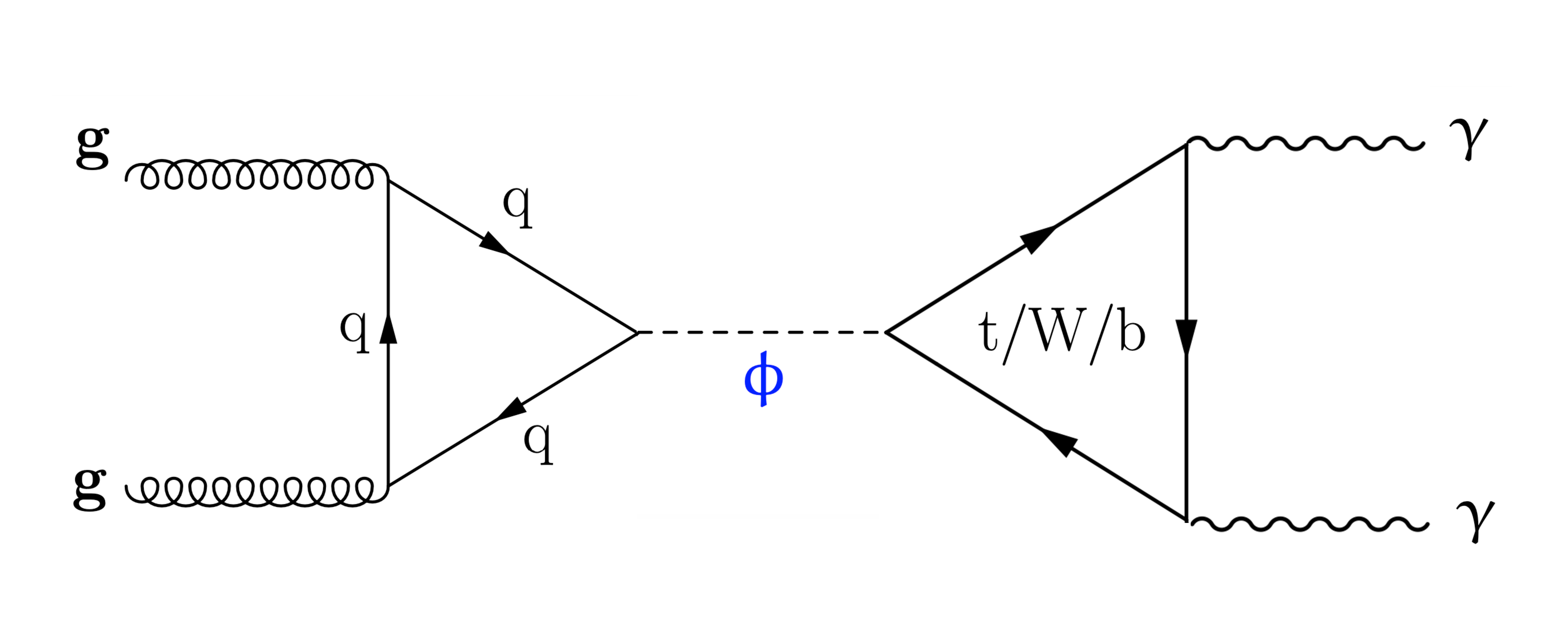
png pdf |
Figure 1:
Feynman diagram of a generic Higgs-like diphoton resonance $ \phi $ produced via gluon fusion decaying into a pair of photons. |
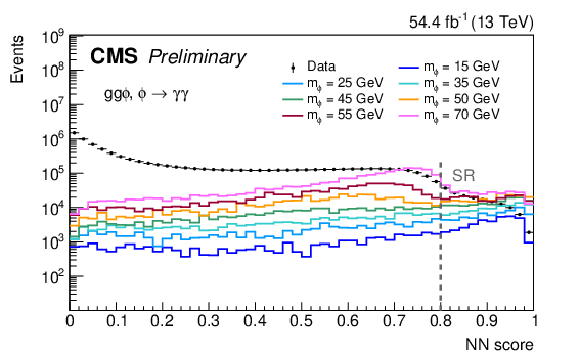
png pdf |
Figure 2:
Distribution of the NN score for signal events at different mass hypotheses generated via gluon fusion, assuming a cross section times branching fraction of 1 pb. A scaling of the signals by a factor 10000 is applied to facilitate a clearer comparison of the signal and background shapes. The observed distribution of data in the preselection region is shown as black dots. The NN score threshold of 0.8 used to define the signal region (SR) is indicated by the gray dashed line. |
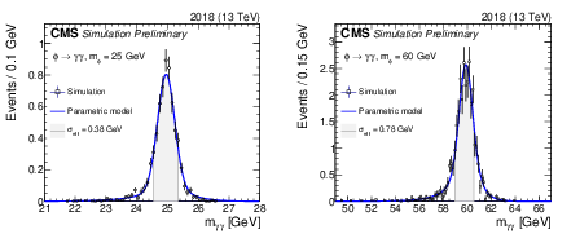
png pdf |
Figure 3:
The parametric signal model (blue solid line), derived from simulation of Higgs-like diphoton signals (square markers), is evaluated at two mass hypotheses: 25 GeV (left) and 60 GeV (right). The typical experimental resolution for the signal is also displayed in terms of the effective $ \sigma $ ($ \sigma_{\textrm {eff}} $), corresponding to the shaded region. The $ \sigma_{\textrm {eff}} $ is defined as the smallest interval that contains 68% of the total probability density. |
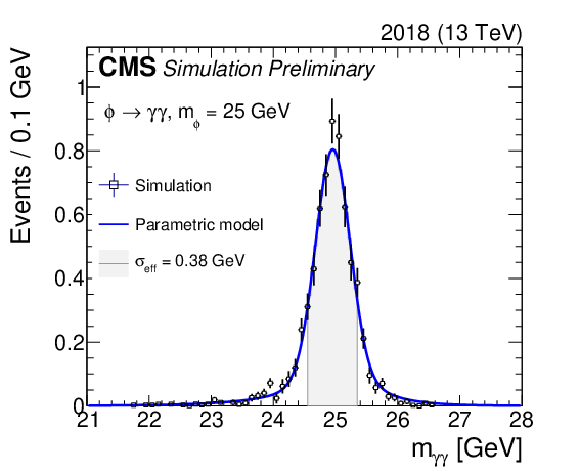
png pdf |
Figure 3-a:
The parametric signal model (blue solid line), derived from simulation of Higgs-like diphoton signals (square markers), is evaluated at two mass hypotheses: 25 GeV (left) and 60 GeV (right). The typical experimental resolution for the signal is also displayed in terms of the effective $ \sigma $ ($ \sigma_{\textrm {eff}} $), corresponding to the shaded region. The $ \sigma_{\textrm {eff}} $ is defined as the smallest interval that contains 68% of the total probability density. |
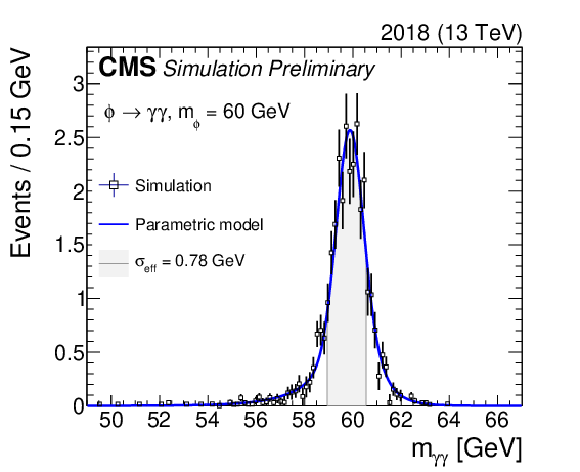
png pdf |
Figure 3-b:
The parametric signal model (blue solid line), derived from simulation of Higgs-like diphoton signals (square markers), is evaluated at two mass hypotheses: 25 GeV (left) and 60 GeV (right). The typical experimental resolution for the signal is also displayed in terms of the effective $ \sigma $ ($ \sigma_{\textrm {eff}} $), corresponding to the shaded region. The $ \sigma_{\textrm {eff}} $ is defined as the smallest interval that contains 68% of the total probability density. |
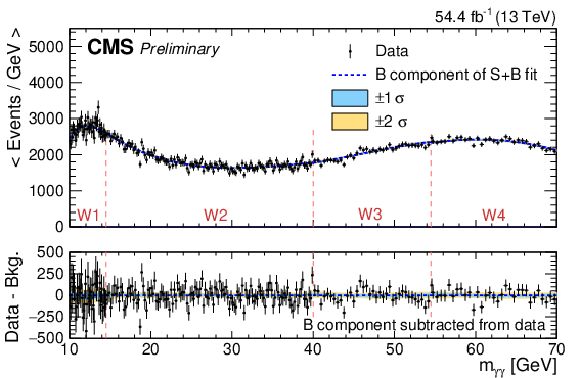
png pdf |
Figure 4:
Upper panel: The data and background component of the signal-plus-background model are shown for each of the four sub-range windows (W1--W4) spanning the diphoton spectrum by using the full dataset from 10 to 70 GeV in the SR. The background fits include one (light blue) and two (yellow) standard deviation uncertainty bands. Lower panel: Residuals in data and uncertainty bands after subtracting the background fit. To illustrate the continuity of the data and fit models across the mass spectrum, event counts in both panels are scaled by the bin width of each sub-range window, leading to an average of event frequency computed for each bin throughout the mass spectrum. |
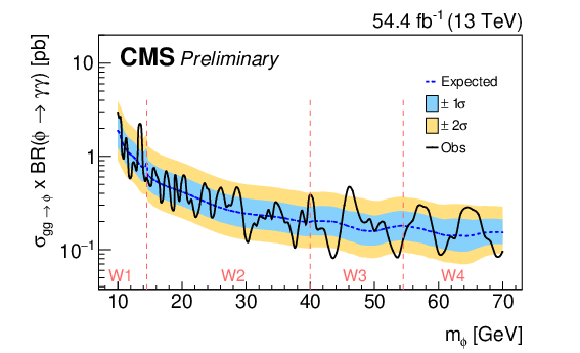
png pdf |
Figure 5:
Expected (dashed blue) and observed (solid black) limits at 95% CL on the gluon fusion production cross section of a narrow diphoton resonance, $ \sigma_{\textrm{gg}\rightarrow\phi} \times $ BR($ \phi \rightarrow\gamma\gamma $), as a function of the mass in the range 10--70 GeV with minimal model-dependent assumptions, along with 1$ \sigma $ (blue) and 2$ \sigma $ (yellow) uncertainty bands from the expected limits. The four sub-range windows spanning the diphoton spectrum as employed for the background modeling are labeled W1--W4. |
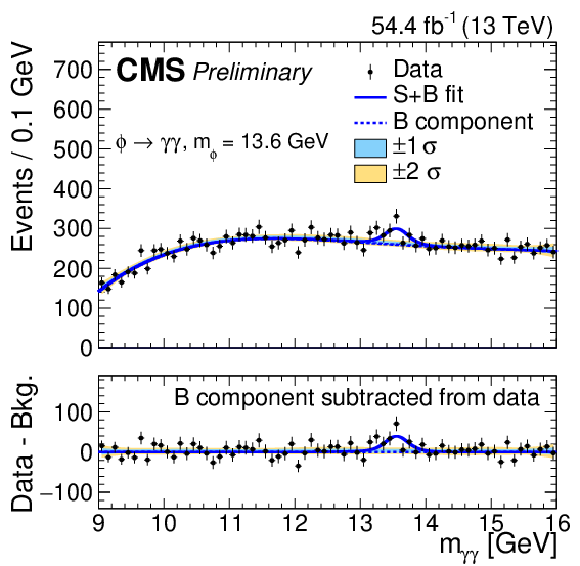
png pdf |
Figure 6:
Signal plus background fits (dark blue) are shown for the most significant excess in the SR at a mass hypothesis of 13.6 GeV, with signal yield freely floating. In the ratio pad, the background model is subtracted from the data. Uncertainty bands at $ \pm 1 \sigma $ (light blue) and $ \pm 2 \sigma $ (yellow) are obtained from toys generated separately for each window. |
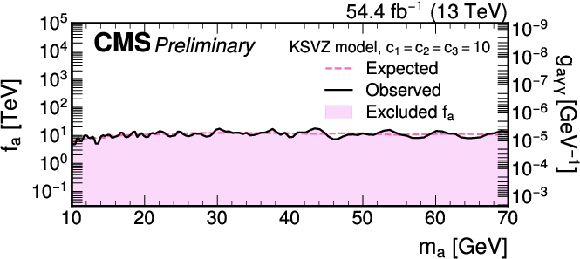
png pdf |
Figure 7:
Recasting of the expected (dashed pink line) and observed (solid black line) upper limits on the gluon fusion production cross section of a diphoton resonance as a function of its mass in the range 10--70 GeV into the ALP parameter space as constraints on the decay constant $ f_a $, assuming $ c_1 = c_2 = c_3 = $ 10. The upper limit on the production cross section corresponds to a lower bound on $ f_a $. The theoretical framework under consideration is the Kim-Shifman-Vainshtein-Zakharov (KSVZ) [83,84] model. The right y-axis shows the corresponding conversion of the limits on $ f_a $ to upper limits on $ g_{a\gamma\gamma} $. |
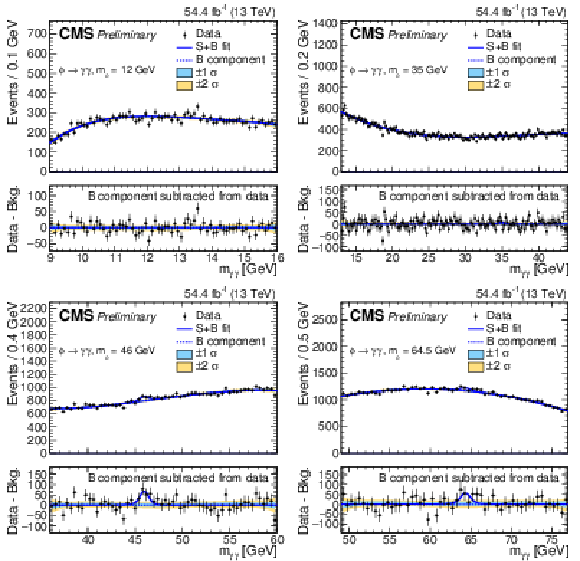
png pdf |
Figure 8:
Signal plus background fits (dark blue) are shown for events entering the signal region (SR) within the four sub-range windows which encompass the low mass range under study in this search. Four mass hypotheses are shown as an example: 12 GeV (top left), 35 GeV (top right), 46 GeV (bottom left), and 64.5 GeV (bottom right), with signal yield freely floating. The best fitting background function in the envelope is displayed, and the signal fit is added at the tested mass point in each window. In the ratio pad, the background model is subtracted from the data. Uncertainty bands at $ \pm 1 \sigma $ (light blue) and $ \pm 2 \sigma $ (yellow) are obtained from toys generated separately for each window. |
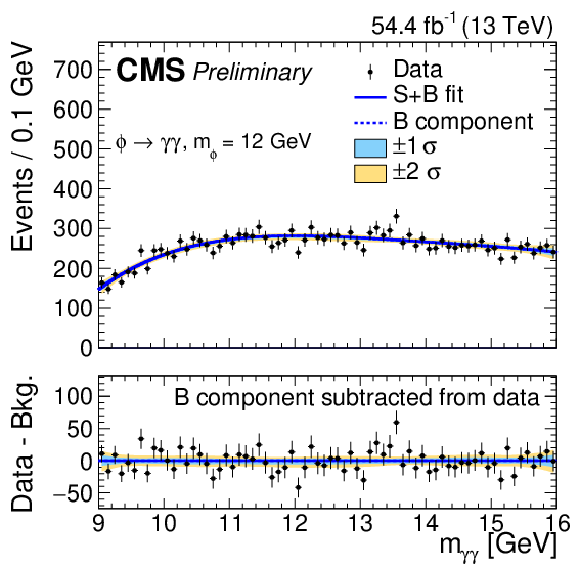
png pdf |
Figure 8-a:
Signal plus background fits (dark blue) are shown for events entering the signal region (SR) within the four sub-range windows which encompass the low mass range under study in this search. Four mass hypotheses are shown as an example: 12 GeV (top left), 35 GeV (top right), 46 GeV (bottom left), and 64.5 GeV (bottom right), with signal yield freely floating. The best fitting background function in the envelope is displayed, and the signal fit is added at the tested mass point in each window. In the ratio pad, the background model is subtracted from the data. Uncertainty bands at $ \pm 1 \sigma $ (light blue) and $ \pm 2 \sigma $ (yellow) are obtained from toys generated separately for each window. |
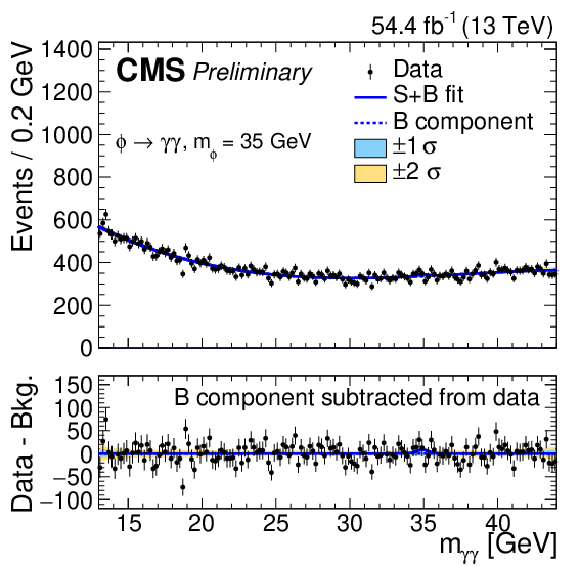
png pdf |
Figure 8-b:
Signal plus background fits (dark blue) are shown for events entering the signal region (SR) within the four sub-range windows which encompass the low mass range under study in this search. Four mass hypotheses are shown as an example: 12 GeV (top left), 35 GeV (top right), 46 GeV (bottom left), and 64.5 GeV (bottom right), with signal yield freely floating. The best fitting background function in the envelope is displayed, and the signal fit is added at the tested mass point in each window. In the ratio pad, the background model is subtracted from the data. Uncertainty bands at $ \pm 1 \sigma $ (light blue) and $ \pm 2 \sigma $ (yellow) are obtained from toys generated separately for each window. |
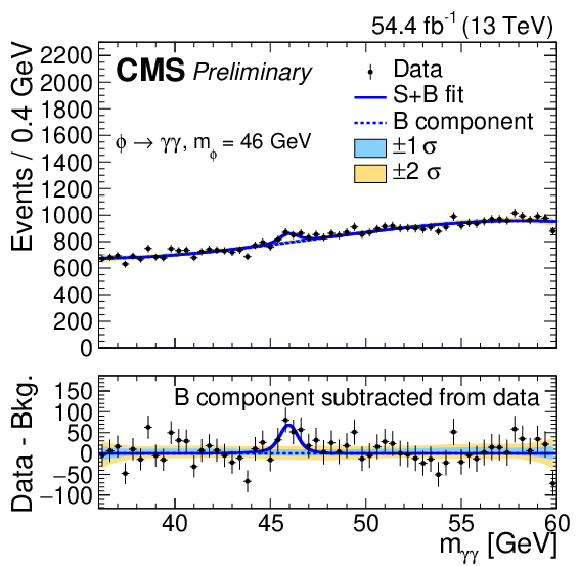
png pdf |
Figure 8-c:
Signal plus background fits (dark blue) are shown for events entering the signal region (SR) within the four sub-range windows which encompass the low mass range under study in this search. Four mass hypotheses are shown as an example: 12 GeV (top left), 35 GeV (top right), 46 GeV (bottom left), and 64.5 GeV (bottom right), with signal yield freely floating. The best fitting background function in the envelope is displayed, and the signal fit is added at the tested mass point in each window. In the ratio pad, the background model is subtracted from the data. Uncertainty bands at $ \pm 1 \sigma $ (light blue) and $ \pm 2 \sigma $ (yellow) are obtained from toys generated separately for each window. |
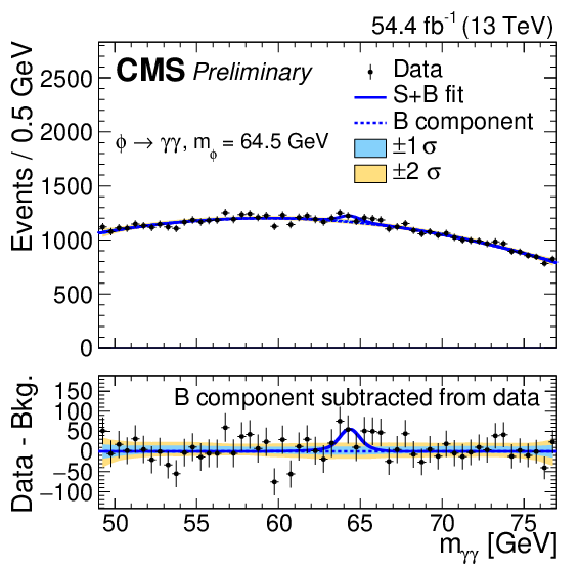
png pdf |
Figure 8-d:
Signal plus background fits (dark blue) are shown for events entering the signal region (SR) within the four sub-range windows which encompass the low mass range under study in this search. Four mass hypotheses are shown as an example: 12 GeV (top left), 35 GeV (top right), 46 GeV (bottom left), and 64.5 GeV (bottom right), with signal yield freely floating. The best fitting background function in the envelope is displayed, and the signal fit is added at the tested mass point in each window. In the ratio pad, the background model is subtracted from the data. Uncertainty bands at $ \pm 1 \sigma $ (light blue) and $ \pm 2 \sigma $ (yellow) are obtained from toys generated separately for each window. |
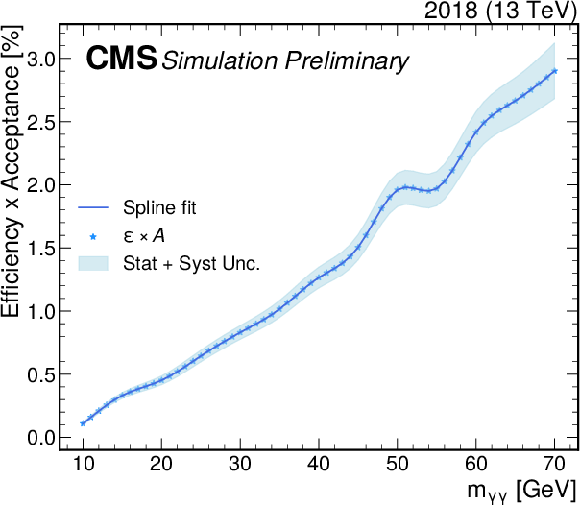
png pdf |
Figure 9:
Efficiency times acceptance for events entering the SR, evaluated using reference simulated signal samples and interpolated with a spline across the mass range 10--70 GeV. The 1$ \sigma $ uncertainty band is built by combining statistical and main experimental systematic uncertainties which affect the signal model. |
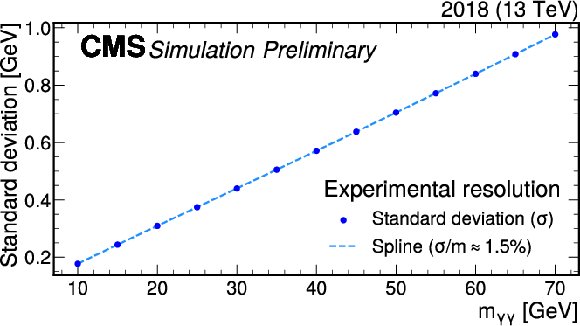
png pdf |
Figure 10:
The gradual variation of the signal experimental mass resolution in the mass range between 10--70 GeV is shown in terms of the standard deviation characterizing the Gaussian core of the distribution ($ \sigma $). A linear parametrization well describes the variation of the mass resolution in the mass range of interest, found to be stable at around 1.5% of the resonance mass. |
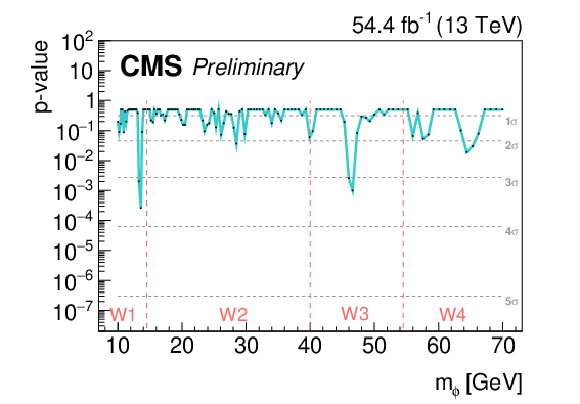
png pdf |
Figure 11:
Local p-value, the probability for a background fluctuation to be at least as large as the observed excess, as a function of the mass. The scan is produced with the same granularity employed for the limit computation. Amongst 130 tested mass hypotheses, six are found to exceed a 2$ \sigma $ local significance. A calculation of the global significance based on toys is provided for the most significant excess observed at a mass hypothesis of 13.6 GeV and it amounts to 1.9 $ \pm $ 0.1$ \sigma $. |
| Summary |
| A novel search for a narrow-width diphoton resonance is conducted in the diphoton invariant mass range between 10 and 70 GeV, enabled for the first time by a new trigger introduced for the CMS data-taking in 2018. An integrated luminosity corresponding to 54.4 fb$ ^{-1} $ of proton-proton collision data at a center of mass energy of 13 TeV is exploited. In this work, the cross-section times branching ratio of a narrow and prompt diphoton resonance is studied across a broad mass range with minimal model-dependent assumptions. Since no significant diphoton signal is observed, 95% CL upper limits are set on the production cross section times branching ratio as a function of the resonance mass. The main sources of uncertainty stem from the limited number of collected pp collisions and from background modeling. The CMS search, based on the 2018 data set only, is able to achieve competitive results per unit of integrated luminosity with respect to ATLAS, and almost comparable limits in the higher mass range. Finally, an interpretation of the limits has been made in the context of ALPs, leading to the first contribution by CMS at such low masses in the picture of diphoton resonance searches. |
| References | ||||
| 1 | A. Arbey and F. Mahmoudi | Dark matter and the early universe: A review | Progress in Particle and Nuclear Physics 119 (2021) 103865 | |
| 2 | Planck Collaboration | Planck 2018 results. VI. Cosmological parameters | Astron. Astrophys. 641 (2020) A6 | 1807.06209 |
| 3 | J. Aubert et al. | Experimental observation of a heavy particle J | PRL 33 (1974) 1404 | |
| 4 | J. Augustin et al. | Discovery of a narrow resonance in $ \mathrm{e}^+\mathrm{e}^- $ annihilation | PRL 33 (1974) 1406 | |
| 5 | S. Herb et al. | Observation of a dimuon resonance at 9.5 GeV in 400-GeV proton-nucleus collisions | PRL 39 (1977) 252 | |
| 6 | UA1 Collaboration | Experimental observation of isolated large transverse energy electrons with associated missing energy at $ \sqrt{s} $=540 GeV | PLB 122 (1983) 103 | |
| 7 | UA1 Collaboration | Experimental observation of lepton pairs of invariant mass around 95 GeV/c$ ^2 $ at the CERN SPS collider | PLB 126 (1983) 398 | |
| 8 | ATLAS Collaboration | Observation of a new particle in the search for the standard model Higgs boson with the ATLAS detector at the LHC | PLB 716 (2012) 1 | 1207.7214 |
| 9 | CMS Collaboration | Observation of a new boson at a mass of 125 GeV with the CMS experiment at the LHC | PLB 716 (2012) 30 | CMS-HIG-12-028 1207.7235 |
| 10 | CDF Collaboration | Observation of top quark production in $ \mathrm{p\bar{p}} $ collisions with the collider detector at Fermilab | PRL 74 (1995) 2626 | |
| 11 | D0 Collaboration | Observation of the top quark | PRL 74 (1995) 2632 | |
| 12 | E. Gildener and S. Weinberg | Symmetry breaking and scalar bosons | PRD 13 (1976) 3333 | |
| 13 | L. Susskind | Dynamics of spontaneous symmetry breaking in the Weinberg-Salam theory | PRD 20 (1979) 2619 | |
| 14 | C. Smith and G. Ross | The real gauge hierarchy problem | Physics Letters B 105 (1981) 38 | |
| 15 | A. Celis, V. Ilisie, and A. Pich | LHC constraints on two-Higgs-doublet models | JHEP 07 (2013) 053 | 1302.4022 |
| 16 | B. Coleppa, F. Kling, and S. Su | Constraining type II 2HDM in light of LHC Higgs searches | JHEP 01 (2014) 161 | 1305.0002 |
| 17 | S. Chang et al. | Two-Higgs-doublet models for the LHC Higgs boson data at $ \sqrt{s}= $ 7 and 8 TeV | JHEP 09 (2014) 101 | 1310.3374 |
| 18 | G. Cacciapaglia et al. | Search for a lighter Higgs boson in two-Higgs-doublet models | JHEP 12 (2016) 68 | 1607.08653 |
| 19 | M. Dine, W. Fischler, and M. Srednicki | A simple solution to the strong CP problem with a harmless axion | PLB 104 (1981) 199 | |
| 20 | M. Drees | Supersymmetric models with extended Higgs sector | Int. J. Mod. Phys. A 4 (1989) 3635 | |
| 21 | S. F. King and P. L. White | Resolving the constrained minimal and next-to-minimal supersymmetric standard models | PRD 52 (1995) 4183 | hep-ph/9505326 |
| 22 | F. Franke | Neutralinos and Higgs bosons in the next-to-minimal supersymmetric standard model | Int. J. Mod. Phys. A 12 (1997) 479 | hep-ph/9512366 |
| 23 | M. Maniatis | The next-to-minimal supersymmetric extension of the standard model reviewed | Int. J. Mod. Phys. A 25 (2010) 3505 | 0906.0777 |
| 24 | U. Ellwanger, C. Hugonie, and A. M. Teixeira | The next-to-minimal supersymmetric standard model | Phys. Rept. 496 (2010) 1 | 0910.1785 |
| 25 | U. Ellwanger and M. Rodriguez-Vazquez | Discovery prospects of a light scalar in the NMSSM | JHEP 02 (2016) 096 | 1512.04281 |
| 26 | J.-W. Fan et al. | Study of diphoton decays of the lightest scalar Higgs boson in the next-to-minimal supersymmetric standard model | Chin. Phys. C 38 (2014) 073101 | 1309.6394 |
| 27 | M. Guchait and J. Kumar | Diphoton signal of light pseudoscalar in NMSSM at the LHC | PRD 95 (2017) 035036 | 1608.05693 |
| 28 | J. Ellis et al. | Higgs bosons in a nonminimal supersymmetric model | PRD 39 (1989) 844 | |
| 29 | J.-Q. Tao et al. | Search for a lighter Higgs boson in the next-to-minimal supersymmetric standard model | Chin. Phys. C 42 (2018) 103107 | 1805.11438 |
| 30 | H. Georgi and M. Machacek | Doubly-charged Higgs bosons | NPB 262 (1985) 463 | |
| 31 | H. E. Logan and V. Rentala | All the generalized Georgi-Machacek models | PRD 92 (2015) 075011 | 1502.01275 |
| 32 | A. Ismail, B. Keeshan, H. E. Logan, and Y. Wu | Benchmark for LHC searches for low-mass custodial fiveplet scalars in the Georgi-Machacek model | PRD 103 (2021) 095010 | 2003.05536 |
| 33 | C. Wang et al. | Search for a lighter neutral custodial fiveplet scalar in the Georgi-Machacek model | Chin. Phys. C 46 (2022) 083107 | 2204.09198 |
| 34 | R. Contino | The Higgs as a Composite Nambu-Goldstone Boson | Contains an overview of composite Higgs phenomenology, including additional scalars, 2010 Lect. Notes Phys. 800 (2010) 215 |
1005.4269 |
| 35 | R. D. Peccei and H. R. Quinn | CP conservation in the presence of pseudoparticles | PRL 38 (1977) 1440 | |
| 36 | C. Abel et al. | Measurement of the permanent electric dipole moment of the neutron | PRL 124 (2020) 081803 | 2001.11966 |
| 37 | D. J. E. Marsh | Axion cosmology | Physics Reports 643 (2016) 1 | |
| 38 | A. Mariotti, D. Redigolo, F. Sala, and K. Tobioka | New LHC bound on low-mass diphoton resonances | PLB 783 (2018) 13 | 1710.01743 |
| 39 | CMS Collaboration | Search for low mass vector resonances decaying into quark-antiquark pairs in proton-proton collisions at $ \sqrt{s}= $ 13 TeV | JHEP 01 (2018) 097 | CMS-EXO-17-001 1710.00159 |
| 40 | CMS Collaboration | Search for a standard model-like Higgs boson in the mass range between 70 and 110 GeV in the diphoton final state in proton-proton collisions at $ \sqrt{s}= $ 13 TeV | Physics Letters B 860 (2025) 139067 | |
| 41 | ATLAS Collaboration | Search for boosted diphoton resonances in the 10 to 70 GeV mass range using 138 fb$ ^{-1} $ of 13 TeV pp collisions with the ATLAS detector | JHEP 07 (2023) 155 | 2211.04172 |
| 42 | ATLAS Collaboration | Search for diphoton resonances in the 66 to 110 GeV mass range using pp collisions at $ \sqrt{s} $ = 13 TeV with the ATLAS detector | JHEP 01 (2025) 053 | 2407.07546 |
| 43 | A. Djouadi | The anatomy of electro-weak symmetry breaking. I: The Higgs boson in the standard model | Phys. Rept. 457 (2008) 1 | hep-ph/0503172 |
| 44 | D. de Florian et al. | Handbook of LHC Higgs Cross Sections: 4. Deciphering the Nature of the Higgs Sector | CERN Yellow Reports:, 2017 Monographs 2 (2017) |
1610.07922 |
| 45 | CMS Collaboration | Reconstruction of decays to merged photons using end-to-end deep learning with domain continuation in the CMS detector | PRD 108 (2023) 052002 | CMS-EGM-20-001 2204.12313 |
| 46 | CMS Collaboration | Particle-flow reconstruction and global event description with the CMS detector | JINST 12 (2017) P10003 | CMS-PRF-14-001 1706.04965 |
| 47 | CMS Collaboration | The CMS experiment at the CERN LHC | JINST 3 (2008) S08004 | |
| 48 | CMS Collaboration | Development of the CMS detector for the CERN LHC Run 3 | JINST 19 (2024) P05064 | CMS-PRF-21-001 2309.05466 |
| 49 | CMS Collaboration | Performance of photon reconstruction and identification with the CMS detector in proton-proton collisions at $ \sqrt{s}= $ 8 TeV | JINST 10 (2015) P08010 | CMS-EGM-14-001 1502.02702 |
| 50 | CMS Collaboration | Energy calibration and resolution of the CMS electromagnetic calorimeter in pp collisions at $ \sqrt{s} = $ 7 TeV | JINST 8 (2013) P09009 | CMS-EGM-11-001 1306.2016 |
| 51 | CMS Collaboration | Electron and photon reconstruction and identification with the CMS experiment at the CERN LHC | JINST 16 (2021) P05014 | CMS-EGM-17-001 2012.06888 |
| 52 | CMS Collaboration | A measurement of the Higgs boson mass in the diphoton decay channel | PLB 805 (2020) 135425 | CMS-HIG-19-004 2002.06398 |
| 53 | CMS Collaboration | Measurement of the inclusive W and Z production cross sections in pp collisions at $ \sqrt{s}= $ 7 TeV | JHEP 10 (2011) 132 | CMS-EWK-10-005 1107.4789 |
| 54 | J. Alwall et al. | The automated computation of tree-level and next-to-leading order differential cross sections, and their matching to parton shower simulations | JHEP 07 (2014) 079 | 1405.0301 |
| 55 | R. Frederix and S. Frixione | Merging meets matching in MC@NLO | JHEP 12 (2012) 061 | 1209.6215 |
| 56 | NNPDF Collaboration | Parton distributions from high-precision collider data | EPJC 77 (2017) 663 | 1706.00428 |
| 57 | T. Sjöstrand et al. | An introduction to pythia 8.2 | Computer Physics Communications 191 (2015) 159 | |
| 58 | CMS Collaboration | Extraction and validation of a new set of CMS PYTHIA8 tunes from underlying-event measurements | EPJC 80 (2020) 4 | CMS-GEN-17-001 1903.12179 |
| 59 | T. Gleisberg et al. | Event generation with SHERPA 1.1 | JHEP 02 (2009) 007 | 0811.4622 |
| 60 | S. Hoeche, F. Krauss, S. Schumann, and F. Siegert | QCD matrix elements and truncated showers | JHEP 05 (2009) 053 | 0903.1219 |
| 61 | J. Alwall et al. | MadGraph 5: Going Beyond | JHEP 06 (2011) 128 | 1106.0522 |
| 62 | GEANT4 Collaboration | GEANT 4 - a simulation toolkit | NIM A 506 (2003) 250 | |
| 63 | CMS Collaboration | Measurements of Higgs boson properties in the diphoton decay channel in proton-proton collisions at $ \sqrt{s} = $ 13 TeV | JHEP 11 (2018) 185 | CMS-HIG-16-040 1804.02716 |
| 64 | A. Hoecker et al. | TMVA - Toolkit for Multivariate Data Analysis | physics/0703039 | |
| 65 | E. Spyromitros-Xioufis, W. Groves, G. Tsoumakas, and I. Vlahavas | Multi-target regression via input space expansion: treating targets as inputs | Mach Learn 104 (2016) | 1211.6581 |
| 66 | CMS Collaboration | Measurements of $ \mathrm{t\bar{t}}H $ Production and the CP Structure of the Yukawa Interaction between the Higgs Boson and Top Quark in the Diphoton Decay Channel | PRL 125 (2020) 061801 | CMS-HIG-19-013 2003.10866 |
| 67 | CMS Collaboration | Measurements of Higgs boson production cross sections and couplings in the diphoton decay channel at $ \sqrt{\mathrm{s}} = $ 13 TeV | JHEP 07 (2021) 027 | CMS-HIG-19-015 2103.06956 |
| 68 | M. Abadi et al. | TensorFlow: Large-scale machine learning on heterogeneous systems | Software available from tensorflow.org link |
|
| 69 | V. Nair and G. Hinton | Rectified linear units improve restricted boltzmann machines | Proceedings of the 27th International Conference on Machine Learning (ICML-10), 2010 | |
| 70 | D. Kingma and J. Ba | Adam: A method for stochastic optimization | International Conference on Learning Representations (ICLR), 2015 link |
|
| 71 | M. Oreglia | A study of the reactions $ \psi^\prime \to \gamma \gamma \psi $ | PhD thesis, Stanford University, SLAC Report SLAC-R-236, 1980 link |
|
| 72 | T. Skwarnicki | A study of the radiative CASCADE transitions between the Upsilon-prime and Upsilon resonances | PhD thesis, Cracow, INP, 1986 link |
|
| 73 | W. Rolke | Supplemental studies for simultaneous goodness-of-fit testing | link | |
| 74 | R. A. Fisher | On the interpretation of $ \chi^{2} $ from contingency tables, and the calculation of $ p $ | J. Royal Stat. Soc 85 (1922) 87 | |
| 75 | P. D. Dauncey, M. Kenzie, N. Wardle, and G. J. Davies | Handling uncertainties in background shapes: the discrete profiling method | JINST 10 (2015) P04015 | 1408.6865 |
| 76 | CMS Collaboration | Observation of the diphoton decay of the Higgs boson and measurement of its properties | EPJC 74 (2014) 3076 | CMS-HIG-13-001 1407.0558 |
| 77 | CMS Collaboration | CMS luminosity measurement for the 2018 data-taking period at $ \sqrt{s} = $ 13 TeV | CMS Physics Analysis Summary, 2019 CMS-PAS-LUM-18-002 |
CMS-PAS-LUM-18-002 |
| 78 | CMS Collaboration | The CMS Statistical Analysis and Combination Tool: COMBINE | CMS-CAT-23-001 2404.06614 |
|
| 79 | E. Gross and O. Vitells | Trial factors for the look elsewhere effect in high energy physics | EPJC 70 (2010) 525 | 1005.1891 |
| 80 | I. Brivio et al. | ALPs Effective Field Theory and Collider Signatures | EPJC 77 (2017) 572 | 1701.05379 |
| 81 | S. Weinberg | A new light boson? | PRL 40 (1978) 223 | |
| 82 | F. Wilczek | Problem of strong P and T invariance in the presence of instantons | PRL 40 (1978) 279 | |
| 83 | J. E. Kim | A theory of the axion | PRL 43 (1979) 103 | |
| 84 | M. A. Shifman, A. I. Vainshtein, and V. I. Zakharov | Can confinement solve the cp problem? | PLB 78 (1979) 443 | |
| 85 | A. Alloul et al. | FeynRules 2.0 - A complete toolbox for tree-level phenomenology | Comput. Phys. Commun. 185 (2014) 2250 | 1310.1921 |
| 86 | J. Alwall et al. | Comparative study of various algorithms for the merging of parton showers and matrix elements in hadronic collisions | EPJC 53 (2008) 473 | 0706.2569 |
| 87 | NNPDF Collaboration | Parton distributions from high-precision collider data | EPJC 77 (2017) 663 | 1706.00428 |
| 88 | Y. Gershtein, S. Knapen, and D. Redigolo | Probing naturally light singlets with a displaced vertex trigger | PLB 823 (2021) 136758 | 2012.07864 |

|
Compact Muon Solenoid LHC, CERN |

|

|

|

|

|

|